The best-known secret in Florence is known of by many, but visited by almost none, and its story runs through the heart of Florentine history, literally and figuratively. Every tourist in Florence will see it, because everyone visits the Ponte Vecchio, and the corridor passes just above it. But few are aware of what they are seeing, inauspicious as it appears from the outside.
The passage is around a kilometer long and runs from the Palazzo Vecchio, the headquarters of the Medici rulers of Florence, to the Palazzo Pitti, a newer residential palace built on the far side of the Arno River. The purpose of the passage was to allow Medici to travel from work to home and back without having to run the gauntlet of the city streets (which occasionally were filled with locals of strong anti-Medici sentiment), while still keeping an eye on proceedings, through the various windows that provide a view outside. It was designed by Giorgio Vasari, court painter to Cosimo de’Medici as well as his lead architect, and best known to posterity as the founder of the field of art history, having penned the first group biography of artists in his 1550, "Lives of the Most Eminent Painters, Sculptors and Architects," which largely established the way we still think about art, collecting and museums today.
Vasari began work on the passage in March 1565 and took only five months to finish, but it did have a deadline: December 16, the date of the elaborate wedding of Francesco I de’Medici and Joanna of Austria, an event for which Vasari was a key planner of decorations and entertainments.
But this was part of a much larger series of renovations with which Vasari was charged by Cosimo. He expanded and redesigned the Palazzo Vecchio (including altering the enormous Sala dei Cinquecento, and in the process removed — and likely hid — Leonardo’s fresco, "The Battle of Anghiari"), and had to join it to the palazzo across the river, which had been built by the banker Luca Pitti, which was acquired by the Medici and was being renovated, as well. Vasari was charged with creating a building to house all the civic offices of Florence, the Florentine bureaucracy and the city magistrates. Of this commission, Vasari wrote:
I have never built anything more difficult or more dangerous, because the foundations stand above the riverbank, almost in mid-air. But it was necessary, among other reasons, to provide a place to attach, as we did, the great corridor that crosses the river from the ducal Palace to the Pitti palace and gardens. It took five months to complete the corridor according to my design, although it looks like the kind of project that would take at least five years.
That building is now Florence’s most famous museum, called the Uffizi, “the Offices.” The corridor project was part and parcel of this complex series of projects.
The logistics of permissions were part of the problem. The trajectory of the corridor passed through towers that had been in place for hundreds of years and were privately own. One such owner was the Mannelli family, and they had no intention of selling to the Medici to move their ancestral home. Rather than force his way through, Cosimo agreed to leave the Mannelli be, and Vasari was obliged to build the corridor snaking around the Mannelli tower.
The corridor provides strategic viewpoints not only out into the city but also into several interiors, allowing Medici to watch while not being accessible, and in some cases barely being seen themselves. A view of the Sala dei Cinquecento watched over official visits, and it continues to the far side of the Arno, with a view into the church of Santa Felicita. But it wasn’t the done thing, for grand dukes to walk a whole kilometer on foot, so a special, miniature carriage for two was installed, to shuttle grandees between the two palaces, along the corridor. It was, in this way, more a road than a walkway.
From the 1930s on, some 1,000 paintings from the Uffizi collection have been housed in the corridor, many of them self-portraits by artists as diverse as Andrea del Sarto and Marc Chagall. Even regular visitors to the Uffizi might not have seen this bevy of treasures, which include paintings by Velazquez, Rembrandt, Delacroix and more.
On May 26, 1993, the Sicilian Mafia launched a terrorist attack on Florence, when a car bomb was detonated next to Torre dei Pulci, beside the Uffizi, killing five and injuring many. A portion of the Uffizi and the Vasari Corridor were damaged, including several of the paintings in the corridor. The paintings, ripped to pieces by the explosion, were reconstituted as best the conservators could and placed back on display, as a reminder of the event. The Vasari Corridor has been closed for renovation for many years but is meant to open in 2018 (the exact date has not yet been announced). This is the year to walk where Vasari, Cosimo and the other grand names of late 16th century Florence trod — if they were lucky enough to be invited.

Shares